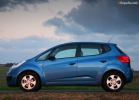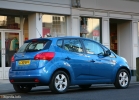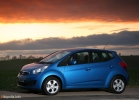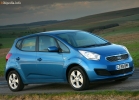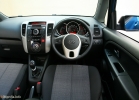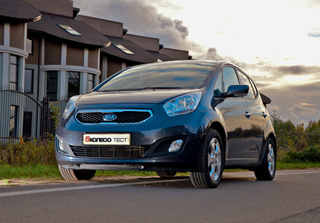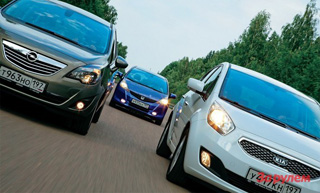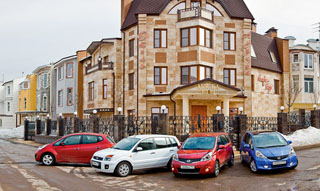Kia Venga test drive since 2009 hatchback
Honda Jazz vs. Kia Venga: Practikers
If in the last comparative test we revealed the winners between the three premium-investors, then this time two compact Honda Jazz and Kia Venga hatchbacks turned out to be the role of duelists, each of which claims to be the most practical and spacious in the classroom.The Honda Jazz Stelaga from the sky in the Russian market is not enough, but has its own client and is in stable demand. In the spring of this year, the hatchback underwent the update, and the main innovation was the replacement of the former robotic transmission by a unavailable variator with a hydrotransformer.

Together with the renewal of Honda, Jazz received a slightly detached appearance and a new transmission.
If the JAZZ model is known, then Kia Venga is new to Russia. The presentation of the hatchback with the silhouette of a minivan teenage took place in February this year. The novelty shares its front -wheel drive platform with Hyundai i20 and Kia Soul. With the appearance of the Vengeri, the chief designer of the South Korean brand Peter Schreyer did not wise and used a corporate template that familiar from other Kia models, which has already proved his own viability.
Kia Venga is a new creation of a South Korean brand. The hatchback with a silhouette of a small minivan is built on the same platform with Kia Soul and Hyundai I20, although it differs from them with a more spacious salon.
The branded grille of the radiator, the front headlights with an Asian squint, the front bumper with a broad smiling mouth of the air intake, a short hood, a large windshield and front racks with additional windows turned out well. Despite a considerable height of 1,600 mm, the CX aerodynamic resistance coefficient is 0.31, which is one of the best indicators in the classroom.
Venga inherited the KIA corporate design, the author of which is the famous Peter Schreyer. Against the backdrop of a pretty Korean, Honda stands out with its extravagance in the Hai Tek style.
The rounded design of the South Korets Honda Jazz sets off the chopped hi-test. The Japanese hatchback was preserved by a familiar wedge -shaped silhouette with a small hump on the hood, highly littered with front racks and a large glazing area. During the restyling, Jazz made a fashionable Mike-AP in the form of a more aggressive front bumper with other foglights, a modified radiator grill and a new collection of alloy discs.
The bright design line Honda continues in the cabin. The main attractions are a stylish steering wheel and front panel.
The Jazz salon meets a beautiful three-spoke steering wheel with a stylish front panel, based on the Honda Civic 5D spacing, which resembles the original control of climate control with a round display. You can’t refuse the practicality of Honda either: two glove boxes (with cooling), convenient cup holders, large pockets in the front doors and several compartments in the console between the seats will make all the necessary small things on the cabin.
Honda Jazz favorably differs in the presence of a two -story cooled glove box. Beautiful tidy with pleasant backlight reads perfectly. The audio system is equipped with the USB entrance. Climate control is released by an original round display.
Kia interior is more modest. Already familiar from other models, the steering wheel, tidy and the central console evoke longing. The only original solution is a two-story climate control twist. Like Honda, the plastic is hard everywhere, and also, Venga, the first KIA model, the audio system of which is not equipped with a USB connector.
The interior of KIA does not shine with design sophisticates. The main elements are borrowed from other KIA models. The profile of the front seats is not perfect, but the side support and length of the pillow are in order. The landing is high.
The front chairs of Honda Jazz have a good profile and good lateral support, but the pillow is short, and the teddy upholstery of the seats is impractical and quickly extended. The Profile of the Seats is worse, but the side support and length of the pillow are in order, and the upholstery is pleasant not only to the eye, but also to the touch. It is noteworthy that both hatchbacks are deprived of full -fledged front armrests. These are available only on the driver's chair.
The spaces in the back in Weng will be enough for three passengers. The sofa has longitudinal adjustment and armrest.
Planting in Kia Venga is high, as in a real minivan. In traffic jams, a big difference in the heights of gas pedals and brakes announce, which is why the right leg quickly gets tired. Planting back is facilitated by large doors opening at a large angle. Places on the gallery are enough with a margin and in length and height, and the absence of the rear tunnel allows even three adult passengers to sit down. The rear sofa has longitudinal adjustment and armrest.
Planting in Honda is no less comfortable, the spaces on the rear sofa of Honda Jazz are slightly smaller, but this is enough for the medium -sized driver to sit behind himself, leaving several free centimeters between the knees and the back of the front chair. However, the roof in jazz is lower, and the rear sofa is deprived of an armrest.
Kia Venga tidy is also good as Honda. The control of climate control is made in the form of an original two-story twist. The top version surprised the lack of USB input.
Kia Venga trunk volume is 440 liters. The rear sofa is laid out in parts, forming an even platform and 1253 liters of free space. If necessary, the floor of the trunk can be lowered below, freeing the excess luggage space. The underground was located underground. The trunk of jazz is inferior with a sofa raised (399 liters) and wins with a folded (1,332 liters). Thanks to the Magic Seats interior transformation system, thanks to which the hatchback interior turns into a real transformer.
As before, Honda Jazz is equipped with a 1.4-liter I-VTEC gasoline engine with a capacity of 100 hp. After updating, instead of a robotic transmission, paired with the engine began to install a stranded CVT variator with a hydrotransformer. As a result, passport acceleration to 100 km/h decreased by a whole second (from 13.6 to 12.6 seconds). We could not find a 1.4-liter Weng, so we took a car equipped with a 1.6 liter with a capacity of 125 hp, which is paired with a 4-speed automatic machine.
I must say that neither Venga nor Jazz do not have outstanding dynamic characteristics, and despite the advantage of 25 hp. Kia is only 0.4 seconds faster than Honda. The reason is almost a 100-kilogram weight difference (not in favor of Kia Venga) and an obsolete four-speed automatic transmission.
Neither Honda nor KIA apply for the title of dynamic car. A 125-horsepower Korean with an old 4-band automaton accelerates to 100 km/h in 12.2 seconds. After restyling, during which jazz replaced the robot with a variator, the Japanese hatchback does this in 12.6 seconds.
In general, KIA gives the impression of a more brisk and dynamic car. The Korean vividly responds to gas, is not afraid of overtaking and calmly holds on a high -speed line. Honda Jazz responds to an accelerator with a lazy one, and high -speed overtaking is better planned in advance: after 120 km/h the dynamics fades away. Honda wins the fuel consumption that was dancing between 7 and 8 liters per 100 km of path, while Kia appetite was 3-4 liters larger.
KIA has more sports control, the reckoning of which is a more rigid suspension, which responds with vibrations to all small joints and irregularities.
Despite the small side of the Honda, the Honda is good at the straight line, it follows the wheel, does not require adjustment of the trajectory and works out the asphalt joints well. The steering wheel has good information and a clear zero, but the efforts are not enough, which is especially noticeable when passing high -speed turns. In the turn of Jazz is heated, but his task is not to burst into a turn with a skid under the discharge of gas, but it is safe to overcome the next connection and it copes with it perfectly. The suspension is practicing pits and bumps with proper comfort, thanks to the police do not shake the tires with an impressive profile (175/65 R15).
The Honda Jazz chassis is weighing to comfort. The suspension copes with small irregularities perfectly, and more pits are held with proper comfort. To the best of the informative steering wheel, there is almost enough effort at speed.
Kia Venga is tougher. He holds the straight line more confident, but all joints and irregularities are felt in the cabin. Despite the dense suspension in the bend, the high body provokes the roll, and most of all annoying too synthetic force on the steering wheel. Validity interferes with the feedback and lubricates the sensations of the severity of the steering wheel. Despite the roll in the turn of the Kia Venga holds better than jazz, and the demolition threshold is higher. But managing slowdown is more convenient in Honda. The brake pedal has excellent informativeness, and the brakes of the backbone in all modes. In KIA, brakes are also effective, but a cotton pedal interferes with accurate dosing.
The main miscalculation of Kia controllability is too synthetic force on the steering wheel, which greatly interferes with the feedback.
As for the cost, they can not boast of a Honda with a humane price tag. Our test was visited by the most packed versions with a full electric packet, climate control, an audio system, heated seats, alloy disks and a stabilization system. In addition, Honda Jazz is equipped with a glass roof. As a result, the price of Honda Jazz amounted to 747,000 rubles, and Kia Venga 738,000 rubles. The basic configurations of the hatchbacks are 615,000 and 614 900 (1.4 liters, 90 hp), respectively.
Even the basic versions of both hatchbacks will have more than 600,000 rubles. The price of top modifications that have been on our test is approaching 750,000 rubles. For this money, the Russian client still pays more attention to bestsellers like Ford Focus or Kia Cee`d.
On the Kia side there is more space in the cabin and sports control, while Honda takes Japanese origin, the best level of comfort, better performance and excellent possibilities for transformation of the salon.
Ruslan Galimov
Photo by Kirill Kalapov
Source: Carclub.ru
Video test drive Kia Venga since 2009
Video Crash tests Kia Venga since 2009
Kia Venga test drive since 2009
Krash-test Kia Venga since 2009
Krassh Test: Detailed Information79%
Driver and passengers
64%
Pedestrians
66%
Children-passengers
71%
Active security system

